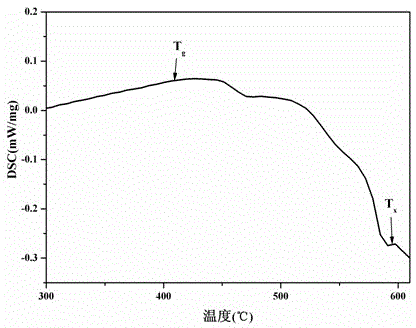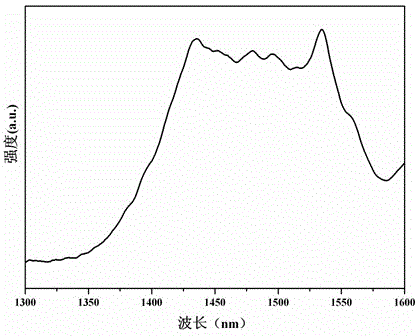Near-infrared broadband luminescence erbium and thulium-co-doped bismuthate laser glass and preparation method thereof
A laser glass and near-infrared technology, applied in the field of laser glass, to achieve the effect of reducing the probability of non-radiative transition, uniform physical and chemical properties, and stable thermodynamic performance
- Summary
- Abstract
- Description
- Claims
- Application Information
AI Technical Summary
Problems solved by technology
Method used
Image
Examples
Embodiment 1
[0029] Composition is as shown in 1# in table 1, and concrete preparation process is as follows:
[0030] According to the molar percentage of the 1# glass composition in Table 1, calculate and weigh the weight of each composition, weigh each raw material and mix them evenly; put the mixture into a corundum crucible and place it on a silicon carbide rod at 1050°C~1100°C Melt in an electric furnace, clarify for 15 minutes after complete melting, and pour the molten glass on the preheated mold; after a little cooling, quickly move it into a muffle furnace with a temperature of 400 ° C, keep it warm for 3 hours, and then use a temperature of 10 ° C / hour The rate was lowered to room temperature, and the glass sample was taken out after complete cooling.
[0031] The test results for this glass are as follows:
[0032] Take a small sample after annealing, grind it into a fine powder with an agate mortar, and conduct a differential thermal analysis test. The differential thermal...
Embodiment 2
[0035] Composition is as shown in 2# in table 1, and concrete preparation process is as follows:
[0036] According to the molar percentage of the 2# glass composition in Table 1, calculate the weight of the corresponding components, weigh the raw materials and mix them evenly; put the mixture into a corundum crucible and melt it in a silicon carbide rod electric furnace at 1050 ° C ~ 1100 ° C, Clarify for 15 minutes after complete melting, and pour the molten glass on the preheated mold; after a little cooling, quickly move it into a muffle furnace with a temperature of 400°C, keep it warm for 3 hours, and then lower it to room temperature at a rate of 10°C / hour, completely The glass samples were removed after cooling.
[0037] The test results for this glass are as follows:
[0038] Take a small sample after annealing, grind it into a fine powder with an agate mortar, and conduct a differential thermal analysis test.
[0039] The annealed sample was processed into a 10×20×...
Embodiment 3
[0041] Composition is as shown in 3# in table 1, and concrete preparation process is as follows:
[0042] According to the molar percentage of the 3# glass composition in Table 1, calculate the weight of the corresponding components, weigh the raw materials and mix them evenly; put the mixture into a corundum crucible and melt it in a silicon carbide rod electric furnace at 1050 ° C ~ 1100 ° C, Clarify for 15 minutes after complete melting, and pour the molten glass on the preheated mold; after a little cooling, quickly move it into a muffle furnace with a temperature of 400°C, keep it warm for 3 hours, and then lower it to room temperature at a rate of 10°C / hour, completely The glass samples were removed after cooling.
[0043] The test results for this glass are as follows:
[0044] Take a small sample after annealing, grind it into a fine powder with an agate mortar, and conduct a differential thermal analysis test.
[0045] The annealed sample was processed into a 10×20×...
PUM
| Property | Measurement | Unit |
|---|---|---|
| width | aaaaa | aaaaa |
Abstract
Description
Claims
Application Information
 Login to View More
Login to View More - R&D
- Intellectual Property
- Life Sciences
- Materials
- Tech Scout
- Unparalleled Data Quality
- Higher Quality Content
- 60% Fewer Hallucinations
Browse by: Latest US Patents, China's latest patents, Technical Efficacy Thesaurus, Application Domain, Technology Topic, Popular Technical Reports.
© 2025 PatSnap. All rights reserved.Legal|Privacy policy|Modern Slavery Act Transparency Statement|Sitemap|About US| Contact US: help@patsnap.com



